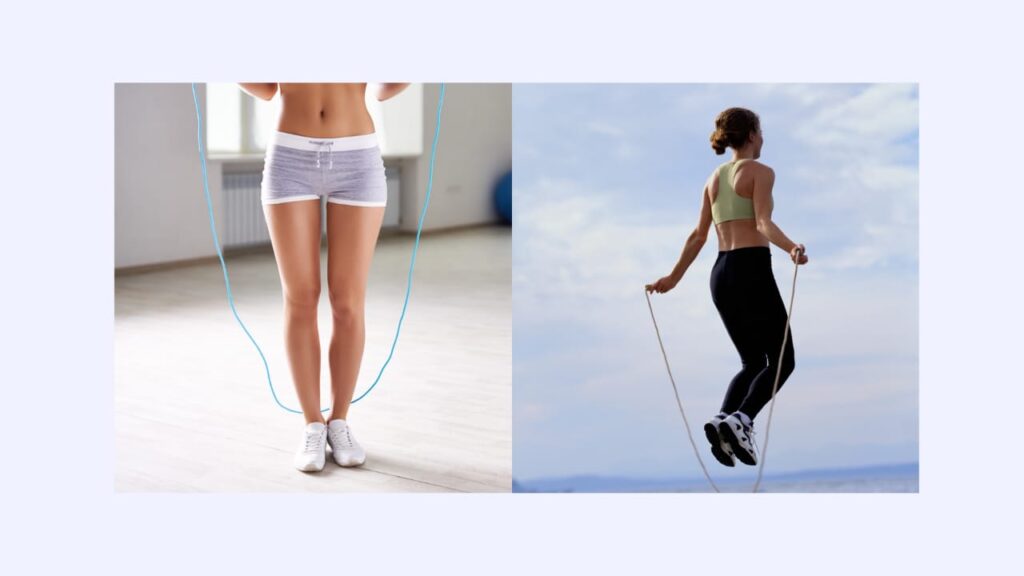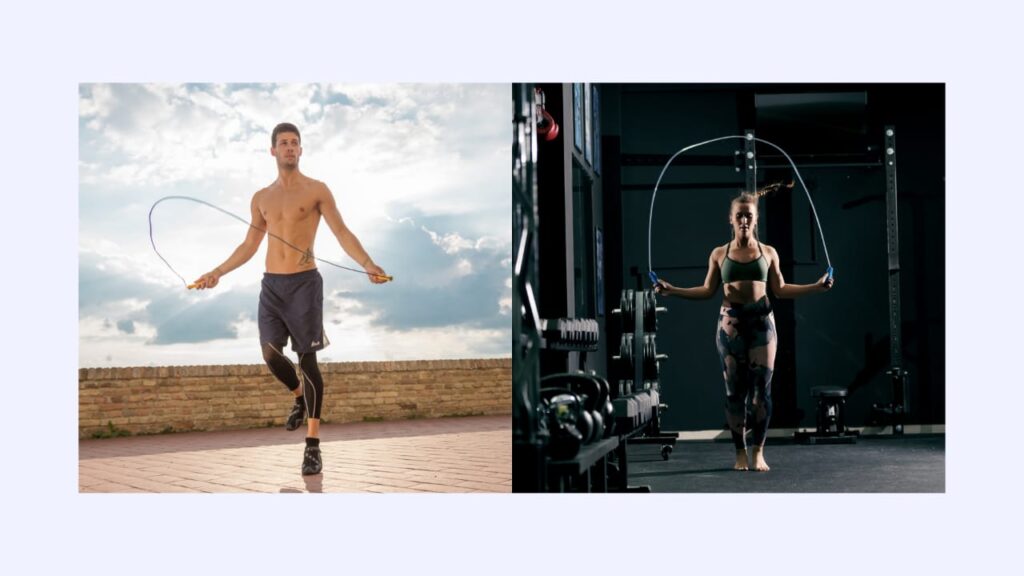How to get better at jump rope is a beat I’ve been hard to solve. It’s like a struggle against a stubborn rival—progress is slow, and problems are common. For all compatible attempts and trials with different methods, the irritation remains.
However, I refuse to submit. Every misstep is a lesson learned, pushing me closer to ability. With resolution and resolve, I’ll keep jumping, knowing that a boost is just a leap away.
Introduction:
Jump rope, a simple yet successful exercise, has been special among athletes, fitness experts, and even kids for its creation. If your point is to better your heart-lung health, increase your flexibility, how to get better at jump rope or simply add a fun object to your workout routine, beating the basics of jump rope is necessary In this extensive guide, we will discuss the step-by-step process of getting better at jumping rope, covering everything from choosing the right rope to controlling basic methods.

Why do I struggle to jump rope?
- Lack of coordination: Jumping rope needs exact timing and heart-lungs between your hands and feet, which can be selected for some individuals.
- Timing issues: Difficulty in conforming to the flow of jumping and swinging the rope can lead to trips and misses.
- Stamina and endurance: Jumping rope constantly can be physically difficult, especially for beginners who may tire quickly.
- Incorrect technique: irregular form, such as using too much arm movement or jumping too high, can slow progress and lead to checking.
- Patience and persistence: Learning jump rope skills takes time and consistent practice, and many people may become disappointed if they don’t see instant improvement.
How to Get Better at Jump Rope:
- Start with the basics: Begin with slow, single jumps to build flow and unity before progressing to more modern methods.
- Focus on form: Check the proper stand and methods, providing your elbows close to your sides and using your wrists to rotate the rope.
- Incorporate drills: Practice specific jump rope drills, such as taking turns, foot jumps, or double unders, to better flexibility and timing.
- Gradually increase intensity: Usually, increase the speed and extent of your jump rope sessions as your energy and stability improve.
- Be patient and consistent. Understand that progress takes time, and don’t get distracted by setbacks. Consistent practice is key to grasping jump rope skills.

How can I increase my jump rope intensity?
If you’re looking to grade up your jump rope workouts, consider many master plans to grow power. Include break training, mix in modern methods like double unders, and aim for faster rotations.
Plus, adding weighted ropes or ankle weights can give an extra challenge. How to Get Better at Jump Rope? Explore these options to raise your workouts and increase your fitness gains.
Understanding the Benefits of Jump Rope:
Before diving into the methods, it’s necessary to understand why jumping rope is such a great exercise. Jumping rope offers a host of benefits, including:
- Improved cardiovascular health: Jumping rope boosts your heart rate, making it a superb heart-lung workout.
- Enhanced coordination and agility: The regular motion of jumping rope challenges your community and flexibility, leading to better overall agility.
- Calorie burning: Jumping rope is a highly successful calorie-burning exercise, making it ideal for weight loss and weight management.
- Portable and convenient: A jump rope is lightweight and moveable, allowing you to catch the exercise almost anywhere, anytime.
Selecting the Right Jump Rope:
Selecting the right jump rope is the first step toward controlling the basics. Consider the following factors when choosing a jump rope: “How to get better at jump rope“:
- Length: Stand on the middle of the rope with one foot and pull the holders upwards. The handles should reach your underarms. Adjust the length correctly.
- Material: Jump ropes come in many materials, such as PVC, beat, and steel cable. Beginners may opt for PVC ropes for elasticity, while modern jumpers may choose steel cables for speed and strength.
- Handle grip: Look for handles with a secure grasp that give a secure hold during jumping sessions.

Mastering the Basic Jump:
The basic jump is the base of all jump rope methods. Follow these steps to master the basic jump: “How to get better at jump rope”
- Start with your feet jointly and hold the jump rope firmly at your sides.
- Vibrate the rope over your head and jump as it greets your feet.
- Land softly on the balls of your feet, giving your knees a slight bend to grip the effect.
- Practice keeping a consistent flow and jumping with both feet together.
Progressing to the Alternate Foot Jump:
Once you’ve learned the basic jump, select yourself for the possible foot jump. Here’s how to do it: “How to Get Better at Jump Rope”:
- Begin in the basic jump position with the rope behind you.
- As you jump, possibly with your feet, raise one foot off the ground while providing the other grounded.
- Land softly, and continue to rotate your feet with each jump.
- Focus on keeping a steady pace and flow throughout the exercise.
Incorporating Double Unders:
Double below is a modern jump rope method that requires rotating the rope twice with each jump. Follow these steps to master double below: “How to Get Better at Jump Rope”:
- Start with the basic jump and grow the speed of the rope rotation.
- Jump rather higher than usual admit the rope to pass twice under your feet.
- Use your carpus to control the speed and timing of the rope rotation.
- Practice timing your jumps to match the rope’s rotation; point for the following double below.
Implementing Jump Rope Workouts:
Once you’ve learned the basic methods, include jump rope workouts in your fitness routine. Here are some typical workouts to try: “How to Get Better at Jump Rope”:
- Interval training: every other time, high-power jumping and rest or active recovery.
- Tabata workouts: Perform 20 seconds of high-power jumping followed by 10 seconds of rest, replicate for a total of four minutes.
- Circuit training: Mix jump rope exercises with bodyweight or power training exercises for a full-body workout.

How can I jump rope more effectively?
To increase jump rope success, focus on form, flow, and breathing. “How to get better at jump rope” Provide elbows close to the body, carpus relaxed, and jump easily on the balls of your feet.
Include interval training and remote methods like Double Below to select yourself and improve collaboration.
How long does it take to get good at jumping rope?
To be better at jumping rope, focus on proper methods, stability, and slow progress. Include mixed workouts, such as gap training and skill drills, to increase flexibility and stability. How to get better at jump rope involves resolve and patience.
- Mastery Timeline: It slowly takes a few weeks of consistent practice to develop basic skills in jump rope methods.
- Individual Progress: The time to better extend is based on factors like fitness level, collaboration, and practice frequency.
- Incremental Growth: Expect a slow boost over months as you refine skills and minimize stability.
- Technique Refinement: Even feedback and adapting to form accelerate progress, decreasing the learning curve.
- Patience and Persistence: Resolving regular practice sessions and holding challenges are key to mastering jump rope skills expertly.
Does a jump rope make you jump higher?
“Want to increase your jump rope skills? Agreeing on practice, focusing on methods, and including varied workouts are key. How to get better at jump rope required resolve and patience, leading to improved flexibility and stability.
- Consistent practice: Frequently allocating time to jump rope sessions improves skill and stability.
- Varied workouts: Include different methods and intervals that challenge the body and increase overall performance.
- Focus on technique: paying attention to proper form and flow increases success and decreases the risk of cuts.
Is jump rope best cardio:
Jump rope is regarded as one of the best cardio exercises due to its success in burning calories and improving heart-lung health. It catches multiple muscle groups together, how to get better at jump rope, resulting in a full-body workout in a short amount of time.
Its flexibility and popularity make it attainable for people of all fitness levels, contributing to its popularity as a press cardio option.
Is it okay to jump rope without shoes?
Is it okay to jump rope without shoes? While some may present discalced jumping, trying proper, strong shoes increases safety and comfort. For those directly looking to improve their jump rope skills, focusing on methods, density, and mixed workouts is key to getting better at jump rope.

Conclusion:
Mastering the basics of jump rope necessary resolve, practice, and patience. By following the one-by-one guide outlined in this article, How to Get Better at Jump Rope, you can better your jump rope skills and take advantage of the many benefits it offers.
If you’re a beginner or an expert jumper, remember to start slowly, focus on proper methods, and slowly minimize the power of your workouts. With resolve and check, you’ll soon be jumping rope like a pro.
